-
 Canadian corporations issued securities worth more than $700 million. The number of shares traded in 1924 was 908,000. Five years later, the number of shares traded grew to over 10 million a year. https://investors.tmx.com/English/overview/historical-timeline/default.aspx
Canadian corporations issued securities worth more than $700 million. The number of shares traded in 1924 was 908,000. Five years later, the number of shares traded grew to over 10 million a year. https://investors.tmx.com/English/overview/historical-timeline/default.aspx -
The history of the important financial and banking events that had a major impact on Canada during the timeline of 1924 - 1931.
-
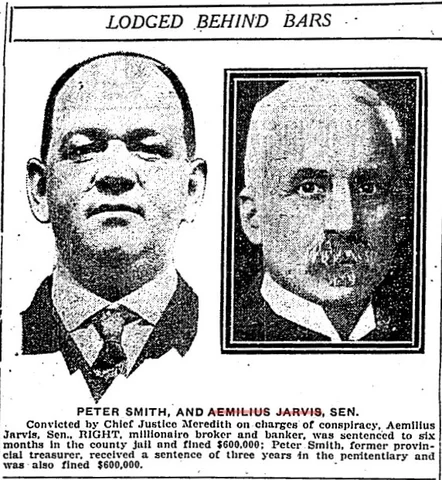 In October 1924, Peter Smith, a former treasurer for the Province of Ontario, and Aemilius Jarvis, one of Canada’s most prominent businessmen and a champion yachtsman, were found guilty of criminal conspiracy to defraud the Ontario government in connection with the repurchase of three series of succession duty-free bonds. https://www.osgoodesociety.ca/book/the-ontario-bond-scandal-of-1924-re-examined/#:~:text=In%20October%2C%201924%2C%20Peter%20Smith,series%20of%20succession%20duty%E2%80%93free
In October 1924, Peter Smith, a former treasurer for the Province of Ontario, and Aemilius Jarvis, one of Canada’s most prominent businessmen and a champion yachtsman, were found guilty of criminal conspiracy to defraud the Ontario government in connection with the repurchase of three series of succession duty-free bonds. https://www.osgoodesociety.ca/book/the-ontario-bond-scandal-of-1924-re-examined/#:~:text=In%20October%2C%201924%2C%20Peter%20Smith,series%20of%20succession%20duty%E2%80%93free -
 Based in Montréal, the Banque Canadienne Nationale issued a series of notes in 1925 that featured familiar Canadian statuary. The design of the $50 note included a portrait of the bank’s President, J.A. Vaillancourt, the bank’s General Manager, Beaudry Leman, and an image of the statue of Maisonneuve in Place d’Armes square in old Montréal. https://www.bankofcanada.ca/wp-content/uploads/2010/07/1926-31.pdf
Based in Montréal, the Banque Canadienne Nationale issued a series of notes in 1925 that featured familiar Canadian statuary. The design of the $50 note included a portrait of the bank’s President, J.A. Vaillancourt, the bank’s General Manager, Beaudry Leman, and an image of the statue of Maisonneuve in Place d’Armes square in old Montréal. https://www.bankofcanada.ca/wp-content/uploads/2010/07/1926-31.pdf -
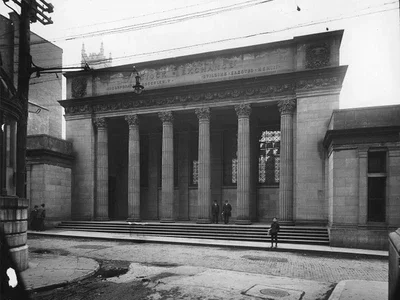 In 1926, the "Montreal Curb Market" was created to allow trading in speculative and junior stocks. If successfully grown, they could apply for a transfer to the main Exchange. In 1953, the Curb Market was renamed the Canadian Stock Exchange. https://en.wikipedia.org/wiki/Montreal_Exchange#:~:text=In%201926%2C%20the%20%22Montreal%20Curb,renamed%20the%20Canadian%20Stock%20Exchange.
In 1926, the "Montreal Curb Market" was created to allow trading in speculative and junior stocks. If successfully grown, they could apply for a transfer to the main Exchange. In 1953, the Curb Market was renamed the Canadian Stock Exchange. https://en.wikipedia.org/wiki/Montreal_Exchange#:~:text=In%201926%2C%20the%20%22Montreal%20Curb,renamed%20the%20Canadian%20Stock%20Exchange. -
 Kenneth Colin Irving was born in 1899 in New Brunswick to the descendants of Scottish settlers. His empire-building began in the 1920s when there was a boom in automobile sales. Car registrations increased dramatically in that decade, and the trend prompted Irving to take ownership of a Ford Motor dealership. In 1926, he was awarded a Ford franchise in Halifax, and the concession for Ford tractors in the whole of the Maritimes. https://www.canadashistory.ca/explore/business-industry/titans
Kenneth Colin Irving was born in 1899 in New Brunswick to the descendants of Scottish settlers. His empire-building began in the 1920s when there was a boom in automobile sales. Car registrations increased dramatically in that decade, and the trend prompted Irving to take ownership of a Ford Motor dealership. In 1926, he was awarded a Ford franchise in Halifax, and the concession for Ford tractors in the whole of the Maritimes. https://www.canadashistory.ca/explore/business-industry/titans -
 Following the resumption of the gold standard in 1926, consideration was briefly given to striking $5 and $10 gold pieces similar to those issued prior to World War I. Copper patterns were prepared, but no further action was taken. https://www.bankofcanada.ca/wp-content/uploads/2010/07/1854-1914.pdf
Following the resumption of the gold standard in 1926, consideration was briefly given to striking $5 and $10 gold pieces similar to those issued prior to World War I. Copper patterns were prepared, but no further action was taken. https://www.bankofcanada.ca/wp-content/uploads/2010/07/1854-1914.pdf -
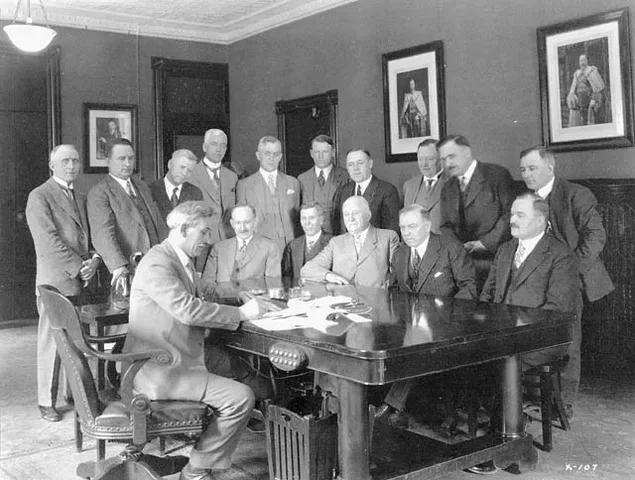 Canada's first public pension plan was introduced in 1927 with the passing of the Old Age Pensions Act. Benefit costs were shared equally between the provinces and the federal government until 1931 when Ottawa's portion was increased to 75 percent. However, British Columbia led the way in this program in 1927. The other three western provinces joined by the end of the decade, as did Ontario. https://www.historymuseum.ca/cmc/exhibitions/hist/pensions/cpp-a28-wcr_e.html
Canada's first public pension plan was introduced in 1927 with the passing of the Old Age Pensions Act. Benefit costs were shared equally between the provinces and the federal government until 1931 when Ottawa's portion was increased to 75 percent. However, British Columbia led the way in this program in 1927. The other three western provinces joined by the end of the decade, as did Ontario. https://www.historymuseum.ca/cmc/exhibitions/hist/pensions/cpp-a28-wcr_e.html -
 The Eastern Bank of Canada was incorporated in 1928 in Saint John. However, a combination of the stock market crash and the inability to find good management caused the bank to close in 1934. Five and ten dollar bank notes were commissioned and printed by The Canadian Bank Note Company. However, notes were never released into circulation by the Eastern Bank of Canada. https://canadacurrency.com/chartered-bank-notes/saint-john/value-of-old-banknotes-from-eastern-bank-of-canada-in-st-john/
The Eastern Bank of Canada was incorporated in 1928 in Saint John. However, a combination of the stock market crash and the inability to find good management caused the bank to close in 1934. Five and ten dollar bank notes were commissioned and printed by The Canadian Bank Note Company. However, notes were never released into circulation by the Eastern Bank of Canada. https://canadacurrency.com/chartered-bank-notes/saint-john/value-of-old-banknotes-from-eastern-bank-of-canada-in-st-john/ -
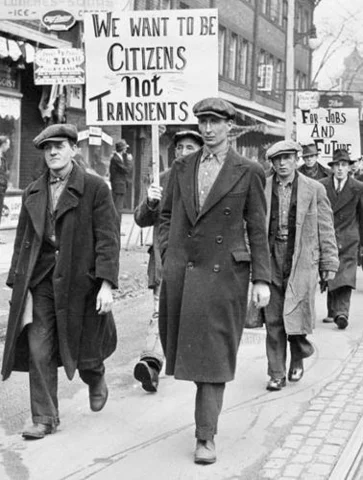 From the peak of the bull market in 1929 to mid-1930, the 50 most active Canadian stocks diminished on average to well under half their market value. Shareholders in International Nickel and Imperial Oil lost more than $500 million each, and those in Canadian Pacific Railway over $60 million. https://www.thecanadianencyclopedia.ca/en/article/the-great-crash-feature
From the peak of the bull market in 1929 to mid-1930, the 50 most active Canadian stocks diminished on average to well under half their market value. Shareholders in International Nickel and Imperial Oil lost more than $500 million each, and those in Canadian Pacific Railway over $60 million. https://www.thecanadianencyclopedia.ca/en/article/the-great-crash-feature -
 Barclays Bank Limited was incorporated in Montreal, Quebec in 1929, as a joint venture between Barclays Bank Limited and Barclays Bank (Dominion, Colonial, and Overseas). Barclays Bank has operated as a retail and commercial bank in Canada from 1929 to 1956, from 1979 to 1996, and most recently from 2010. https://en.wikipedia.org/wiki/Barclays_Bank_Canada#:~:text=Barclays%20Bank%20(Canada)%20Limited%20was,Dominion%2C%20Colonial%20and%20Overseas).
Barclays Bank Limited was incorporated in Montreal, Quebec in 1929, as a joint venture between Barclays Bank Limited and Barclays Bank (Dominion, Colonial, and Overseas). Barclays Bank has operated as a retail and commercial bank in Canada from 1929 to 1956, from 1979 to 1996, and most recently from 2010. https://en.wikipedia.org/wiki/Barclays_Bank_Canada#:~:text=Barclays%20Bank%20(Canada)%20Limited%20was,Dominion%2C%20Colonial%20and%20Overseas). -
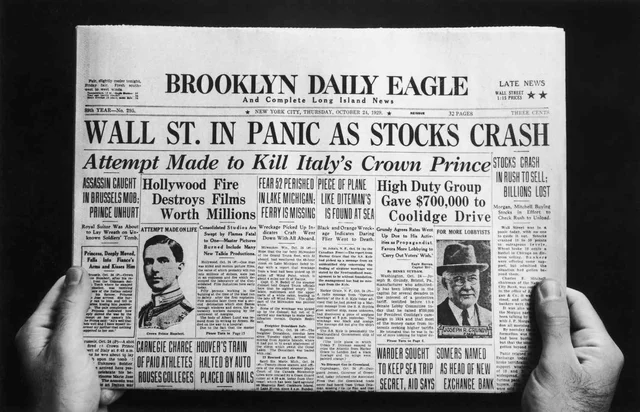 The crash began to shape on October 24, 1929. Thousands of accounts were wiped out before leading bankers and industrialists intervened to halt the slump. The dread extended to the Toronto markets, the Globe declared, and “rocked” share prices there. In Montréal, forced selling ran uncontrolled, and practically every stock finished the day down. https://www.thecanadianencyclopedia.ca/en/article/the-great-crash-feature
The crash began to shape on October 24, 1929. Thousands of accounts were wiped out before leading bankers and industrialists intervened to halt the slump. The dread extended to the Toronto markets, the Globe declared, and “rocked” share prices there. In Montréal, forced selling ran uncontrolled, and practically every stock finished the day down. https://www.thecanadianencyclopedia.ca/en/article/the-great-crash-feature -
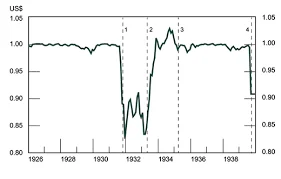 In 1928, the ordinary Advance Rate was reduced to 4.5 percent. It stayed at this level until late October 1931, despite the Canadian dollar falling below the gold-export point during late 1929 and early 1930 and again through the summer of 1931. In effect, if not in form, Canada went off the gold standard in 1929. However, the export of gold was not officially banned until 31 October 1931 by an Order-in-Council. https://www.bankofcanada.ca/wp-content/uploads/2010/07/dollar_book.pdf
In 1928, the ordinary Advance Rate was reduced to 4.5 percent. It stayed at this level until late October 1931, despite the Canadian dollar falling below the gold-export point during late 1929 and early 1930 and again through the summer of 1931. In effect, if not in form, Canada went off the gold standard in 1929. However, the export of gold was not officially banned until 31 October 1931 by an Order-in-Council. https://www.bankofcanada.ca/wp-content/uploads/2010/07/dollar_book.pdf
